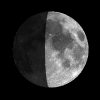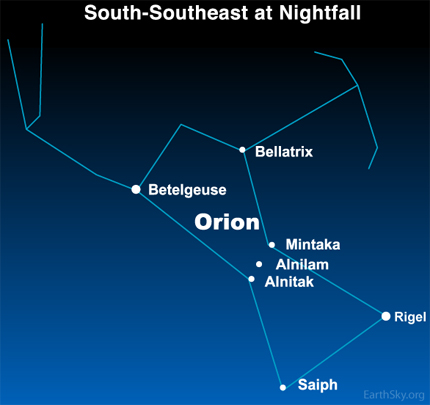Courtesy of EarthSky
A Clear Voice for Science
Visit EarthSky at
www.EarthSky.org

 Orion the Hunter is one of the most prominent constellations in all the heavens. You cannot fail to spot Orion’s Belt – three medium-bright stars in a short, straight row – if you look eastward in the evening. The magnificent Orion Nebula, or M42, is a fuzzy patch in Orion’s Sword.
Orion the Hunter is one of the most prominent constellations in all the heavens. You cannot fail to spot Orion’s Belt – three medium-bright stars in a short, straight row – if you look eastward in the evening. The magnificent Orion Nebula, or M42, is a fuzzy patch in Orion’s Sword.
Most constellations have only one bright star, but Orion has two: Rigel and Betelgeuse. Rigel is Orion’s left foot. A blue-white supergiant and one of the most luminous stars known, it is nearly 800 light-years away. If it were as close as Sirius, the brightest star visible to the eye (and only about 8.6 light-years away), Rigel would shine much more brilliantly than Venus, our sky’s brightest planet.
Betelgeuse – the other bright star in Orion – is the Hunter’s right shoulder. A red supergiant, Betelgeuse is no slouch of a star either. In fact, if Betelgeuse replaced the sun in our solar system, its outer layers would extend past Earth and Mars and to nearly the orbit of Jupiter.
![]() Written by Deborah Byrd
Written by Deborah Byrd
Astronomy Picture of the Day from NASA/JPL
U.S. Naval Observator Astronomical Information center
The York County Astronomical Society
 Print This Post
Print This Post








